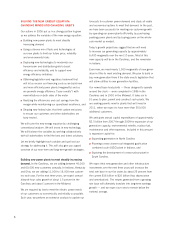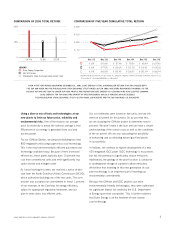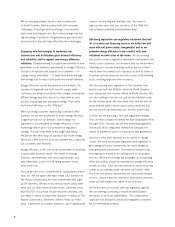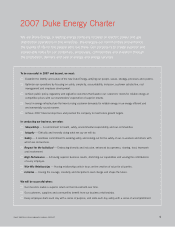Duke Energy 2006 Annual Report Download - page 18
Download and view the complete annual report
Please find page 18 of the 2006 Duke Energy annual report below. You can navigate through the pages in the report by either clicking on the pages listed below, or by using the keyword search tool below to find specific information within the annual report.16
To meet the growing demand for power, we are investing
in a new generation of highly efficient and environmentally
advanced power plants, new environmental controls for
existing plants, and transmission and distribution system
upgrades. Our emphasis on new energy efficiency programs
and technologies will help meet growing demand.
We call energy efficiency the “fifth fuel” because it comple-
ments coal, nuclear power, natural gas and renewable
energy, the four primary sources of electric power for the
future. We see it as one of our most promising solutions,
because the most environmentally sound, inexpensive and
reliable kilowatt-hour is the one we don’t have to produce.
Generating “save-a-watts” is just one part of the equation
that requires our customers to change how they use elec-
tricity. We are looking at ways to help them do that.
UNDERSTANDING THE VARIABLES
Solving the new energy equation means understanding all
of its variables. One of the most significant and unpredict-
able variables is future environmental regulation. Today’s
irregular patchwork of federal and state environmental
requirements has already prompted substantial investments.
Recognition of global warming as a serious problem has
increased the call for regulation of greenhouse gases,
primarily carbon. Mandatory carbon dioxide (CO2)
emission reductions are being considered in Congress.
When legislation passes, utilities will need to make
substantial investments to comply. It is critical that any
such carbon regulations be phased in to avoid causing
economic disruption and that the affected companies
receive emission allowances to defray the cost
of compliance.
POLICY LEADERSHIP
Our stakeholders, particularly our customers, investors and
communities, expect us to play a leading role in shaping
a national policy that addresses this national and global
challenge. We take that responsibility seriously. Our goal is
a policy that will slow the growth of greenhouse gases and
then begin to reduce them — while protecting the economy
and our customers from price shocks.
Another variable is the prospect of mandatory renewable
portfolio standards (RPS) at both the federal and state level.
Twenty-two states currently have such standards, which
require electric utilities to generate anywhere from 5 to
20 percent of their power from “climate-friendly” renewable
energy sources such as solar, wind, geothermal and agri-
cultural waste, over varying periods of time. Congress is
evaluating legislative proposals for a national RPS.
As a company focused on sustainability, we have invested
in pilot projects involving wind and agricultural waste so
that we can gain an understanding of the technologies
and costs that would be required on a larger scale before
mandatory standards are put in place. Today, we are also
the second-largest generator of renewable hydroelectric
power in the United States.
Like any other publicly traded company, we have a
responsibility to meet our customers’ needs while
recovering our investments and earning a good return
on those investments for our shareholders. To solve the
new energy equation, we must use nuclear, coal, natural
gas, renewable energy and energy efficiency. Our strategy
for doing so is outlined on the following pages.
























